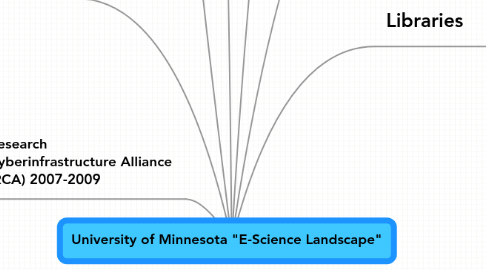
1. Office of the Vice President for Research (OVPR)
1.1. Terra Populus NSF DataNet award (2011)
1.2. Infrastructure Investment Initiative (I3) (2001)
1.2.1. internal granting program
1.3. Minnesota Population Center (transferred to OVPR in 2009)
1.4. MSI - Minnesota Supercomputing Institute (transferred to OVPR in 2009)
1.5. Research Infrastructure Plan (2007)
1.5.1. Set/Review Goals
1.5.1.1. strategic approach to research infrastructure
1.5.1.2. align with institutional goals/strategies implement planing process leverage existing investments forecast major needs to increase competitiveness provide information
1.5.2. Advisory Group (Deans)
1.5.3. listening Sessions (Faculty)
1.5.3.1. 6 sessions
1.5.3.2. 120 fac/65 web comments
1.5.3.3. Tends: interdisiplinary computation/visualization international partnerships
1.5.4. inventory of existing Inrfastructure
1.5.4.1. Geology research ex.
1.5.4.2. 345 sharable items
1.5.5. Recommendations/priorities
1.5.5.1. 1. limit centrally-supported infrastructure and focus on priority projects meeting set criteria
1.5.5.2. 2. establish infrastructure clusters: ie. GIS imaging/visualization aquatic/atmospheric modeling super-computing proteomics/spectroscopy
1.5.5.3. 3. rank clusters in priority groups/ review every two years
1.5.6. Consensus (libraries, IT, capital plan/budget)
1.6. Transforming the U for the 21st Century, Strategic Positioning Report (2007)
1.7. Task Force on Research Infrastructure (2006)
2. Collegiate Units
2.1. CLA
2.1.1. Statistical support
2.1.2. GIS around Campus
2.1.3. Grant funding
2.2. CFANS
2.3. CSE
2.3.1. MAST Lab (NEESHub)
3. Research Cyberinfrastructure Alliance (RCA) 2007-2009
3.1. 2009 Charge: Discuss how to leverage existing commonalities of CyberInfrastructure
3.2. Web site planning for self-service access to existing CI
3.3. Core Services Inventory Mapping Portfolio
3.4. PEL: Implementing Cyberinfrastructure (2008-2009)
3.4.1. Current state of research CI on campus/peer instititons
3.4.1.1. Local CI Inventory
3.4.1.2. Survey Peer institutions
3.4.2. Understand needs/priorities of researchers and CI partners
3.4.2.1. Survey
3.4.2.2. Methodology of participant selection
3.4.3. Develop an outreach program for available services
3.4.3.1. Web site (RCA team working)
3.5. RCA Assessment Report (Celeste, 2008)
3.6. 3-year plan (09-11)
4. Collaborations
4.1. SciVal (LIB, AHC, OVPR, Colleges, OIT)
4.2. Institute on the Environment (IonE) (2008?)
4.3. Institute for Advanced Studies (focus on the humanities)
4.4. U-Spatial I3 grant
5. Academic Heath Center
5.1. AHC Information Exchange (2011)
5.2. Clinical and Translational Sciences Award (CTSA) grant received (2011)
5.3. UMN Profiles (2010)
5.4. Clinical and Translational Sciences Institute (CTSI) (2009)
5.5. Institute for Health Informatics (2005-)
5.6. Center for Biomedical Research Infomatics (CBRI)
6. Libraries
6.1. Research Support Services Collaborative (RSSC) (2011-)
6.1.1. Data Management, Access, and Archiving
6.1.2. Digital Arts and Humanities
6.1.3. Research Communities and Networks
6.2. E-science and Data Services Collaborative (2008-10)
6.2.1. RCA Web Development
6.2.2. GIS data repository
6.2.3. Data Stewardship Report (2009)
6.2.4. Educational Program
6.2.5. Info Gathering peer- library efforts
6.3. ARL report, "Agenda for Developing E-Science in Research Libraries" (2007)
6.4. Sciences Assessment (2007)
6.5. Health Informatics Center (Space/facilities)
6.6. Harvest Choice
6.7. EthicShare (2007-)
6.8. Antarctic Data Repository
6.9. Mellon Report on Art-Humanities/Social Sciences (2006)
6.10. AgEcon Search (1995-)
7. OIT
7.1. Bulk storage purchase (2012)
7.2. Pilot data audits (2011)
7.3. Information Technology Leadership Alliance
7.3.1. Research Data Center Group
7.4. 6-year IT plan (2008)
7.4.1. Goals: manage IT investment portfolios to align with Research
7.4.1.1. Faculty Activity Reporting
7.4.1.2. GIS (space, utilities, roads)
7.4.1.3. Research Compliance Database
7.4.2. investing in the future
7.4.2.1. CIC Data Cloud?
7.4.2.2. RCA: to provide advanced/secure computational infrastructure for 21st century research
7.4.3. Advisory Team
7.4.3.1. determine Impact/value
7.4.3.2. Determine Risk
